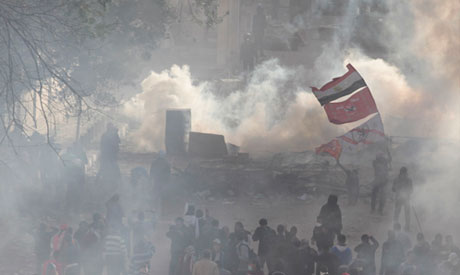 Since the eruption of last year's January 25 Revolution, Egyptians have lived through anxious nights filled with fear and violence. But nothing has been more painful than the four days of clashes in November of last year on Cairo's now-iconic Mohamed Mahmoud Street.
Since the eruption of last year's January 25 Revolution, Egyptians have lived through anxious nights filled with fear and violence. But nothing has been more painful than the four days of clashes in November of last year on Cairo's now-iconic Mohamed Mahmoud Street.
"The battle of Mohamed Mahmoud was not over power, it was a battle for dignity," activist Nazli Hussein said.
The story began when security forces attacked a sit-in in Cairo's nearby Tahrir Square on the morning of 19 November. The sit-in had been organised to demand that Egypt's then-ruling Supreme Council of Armed Forces (SCAF) relinquish power to a civilian authority.
Many of those in the sit-in were relatives of people killed during the 18-day Tahrir Square uprising some nine months earlier, along with a number of injured and a handful of political activists.
Fierce clashes
Protesters and doctors who participated described the clashes that followed as the "most brutal" since the 25 January uprising, ultimately leaving 47 killed and thousands injured. On-and-off street battles between protesters and security forces, the latter of which included police and army personnel, dragged on for four days.
"It wasn't an attempt to merely disperse demonstrators, it was systematic revenge; the intentional injury of protesters," Dr. Yehia Salah El-Din, an eye doctor at Cairo's Qasr Al-Eini Hospital, told Ahram Online.
Salah El-Din, who took part in several protests in the wake of the revolution, recalls that the majority of those whom he treated at the time had sustained injuries to their eyes or faces, which is very traumatic and requires considerably psychological rehabilitation.
The protesters who fell during the clashes, which erupted following a Friday Tahrir Square rally, included photographers, journalists, activists, doctors, engineers and students – even, in some cases, the homeless.
"The real heroes were the poor, whom many of us had been brought up to fear," Mohamed Mahmoud protester Ashraf Ahmed said.
Generally speaking, most of the protesters who faced off with security forces were Egyptian youth, ready to sacrifice their lives for a better Egypt.
"My brother was killed on 28 January, at the height of the revolution," 17-year-old protester Ayman Salah told Ahram Online. "But the revolution obviously wasn't enough, so I joined the Mohamed Mahmoud clashes to say 'enough to treating us like private property."
The level of violence used by security forces – who used teargas and live ammunition to disperse protesters armed only with stones and Molotov cocktails – enraged many Egyptians. At one point, a video appeared online showing military personnel throwing the prone body of one protester onto a garbage heap, further infuriating public opinion.
At one point, the teargas became so thick that local residents complained about it to the authorities. A number of protesters later complained of severe physical side effects resulting from the toxic gasses encountered.
Political implications
The Mohamed Mahmoud clashes also deeply impacted public perceptions of both the then-ruling SCAF and the political parties who refrained from taking part in the skirmishes.
"While people were risking their lives, the political elites were busy campaigning for upcoming elections," political analyst Hesham Sallam told Ahram Online. "The Muslim Brotherhood was a case in point."
The Muslim Brotherhood and its newly-established Freedom and Justice Party came in for particular criticism for their strategic decision not to take part in the ongoing fighting. Rather, they focussed largely on Egypt's first post-Mubarak parliamentary elections, slated to kick off on 28 November.
Although the Brotherhood had participated in the 18 November Tahrir Square rally (held to protest the SCAF-appointed government's proposals for 'supra-constitutional principles'), it refrained from joining the clashes on Mohamed Mahmoud Street.
According to Sallam, the group feared that mounting violence and chaos in downtown Cairo could lead to the postponement – or downright cancelation – of the scheduled parliamentary polls, in which the group hoped to achieve substantial electoral gains.
A turning point
Despite these political considerations, however, and despite the mounting death toll, protesters continued to pour onto Mohamed Mahmoud Street. One year later, many of those who took part in the clashes say the experience changed their lives forever – along with Egypt's political trajectory.
"The experience changed my views about many things," Hussein told Ahram Online. "The clashes, which marked the first time for thousands of Tahrir Square protesters to chant against military rule, showed us that power is actually in the hands of the people."
The clashes, which led to numerous subsequent marches and rallies against military rule, ultimately forced the SCAF to provide a formal timetable for relinquishing political power. And in June of this year – following free parliamentary polls – the military council formally handed executive power over to Mohamed Morsi, the Muslim Brotherhood's presidential candidate.
"Without the Mohamed Mahmoud protests, the SCAF might have remained in power for two or three more years," Sallam asserted.
Meanwhile, some 378 Egyptians arrested during last year's clashes were finally granted an amnesty on Saturday, 17 November. Only one person arrested during the clashes, who authorities accuse of being a drug dealer, remains in custody today.
Egyptian political parties are now calling for rallies to mark the Mohamed Mahmoud clashes' one-year anniversary. Dubbed 'eyes freedom,' the events will commemorate the many protesters who lost their eyes – or worse, their lives – in the four days of street fighting that forever changed Egypt.



